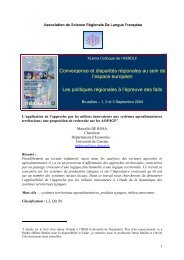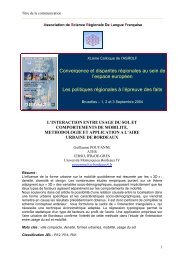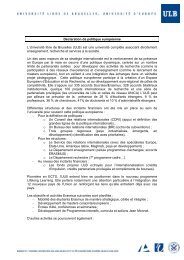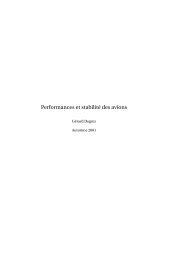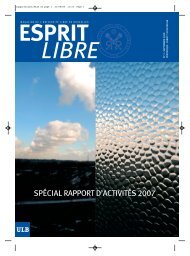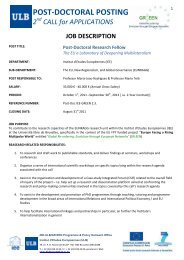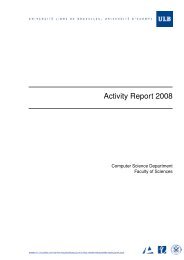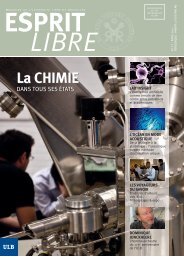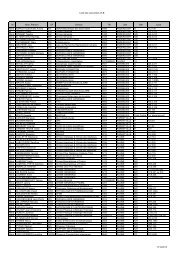Human-impacted mangroves in Gazi (Kenya): predicting future ...
Human-impacted mangroves in Gazi (Kenya): predicting future ...
Human-impacted mangroves in Gazi (Kenya): predicting future ...
You also want an ePaper? Increase the reach of your titles
YUMPU automatically turns print PDFs into web optimized ePapers that Google loves.
MARINE ECOLOGY PROGRESS SERIES<br />
Vol. 272: 77–92, 2004 Published May 19<br />
Mar Ecol Prog Ser<br />
<strong>Human</strong>-<strong>impacted</strong> <strong>mangroves</strong> <strong>in</strong> <strong>Gazi</strong> (<strong>Kenya</strong>):<br />
predict<strong>in</strong>g <strong>future</strong> vegetation based on retrospective<br />
remote sens<strong>in</strong>g, social surveys, and tree distribution<br />
F. Dahdouh-Guebas 1, 2, *, I. Van Pottelbergh 1 , J. G. Kairo 3,1 , S. Cannicci 4 , N. Koedam 1<br />
1 Biocomplexity Research Team, Laboratory of General Botany and Nature Management, Mangrove Management Group,<br />
Vrije Universiteit Brussel, Ple<strong>in</strong>laan 2, 1050 Brussels, Belgium<br />
2 Uitgegeven met steun van de Universitaire Sticht<strong>in</strong>g van België, Egmontstraat 11, 1000 Brussels, Belgium<br />
3 <strong>Kenya</strong> Mar<strong>in</strong>e and Fisheries Research Institute, PO Box 81651, Mombasa, <strong>Kenya</strong><br />
4 Dipartimento di Biologia Animale e Genetica ‘Leo Pardi’, Università degli Studi di Firenze, Via Romana 17, 50125 Firenze, Italy<br />
ABSTRACT: <strong>Gazi</strong> Bay, <strong>Kenya</strong>, covers an area of 18 km 2 , and its <strong>mangroves</strong> are degraded. We present<br />
a quantitative and qualitative evaluation of the degradation of vegetation structure and dynamics of<br />
mangrove communities over a period of 25 yr, us<strong>in</strong>g aerial photography <strong>in</strong> a geographical <strong>in</strong>formation<br />
system (GIS), comb<strong>in</strong>ed with ground-truth data for different vegetation layers, and with faunal<br />
and environmental factors. Retrospective analysis and understand<strong>in</strong>g of current practices were aided<br />
by <strong>in</strong>terviews with <strong>Gazi</strong> village elders and by field observations of mangrove tree stumps. GIS-based<br />
vegetation maps were comb<strong>in</strong>ed with data obta<strong>in</strong>ed us<strong>in</strong>g the po<strong>in</strong>t-centred quarter method<br />
(PCQM), an accuracy analysis was performed, and forestry parameters were derived from the resultant<br />
PCQM data. In addition to general human-<strong>in</strong>duced degradation of vegetation structure and<br />
floristic composition of the seaward mangrove zone, a particular sandy beach is expand<strong>in</strong>g at the<br />
expense of mangrove, whereas the back mangrove zone has undergone m<strong>in</strong>or changes. Aerial<br />
photographs of 1992 and current field data show an apparent zonation of 6 different monospecific or<br />
mixed mangrove communities, with a high importance of Rhizophora mucronata <strong>in</strong> each community<br />
and each vegetation layer. Retrospective vegetation structure was comb<strong>in</strong>ed with correspondence<br />
analyses on the PCQM data derived for adult, young and juvenile trees <strong>in</strong> order to make predictions.<br />
Present dynamics <strong>in</strong>itiated by anthropogenic degradation of <strong>mangroves</strong> cont<strong>in</strong>ues, even though<br />
human impact has dim<strong>in</strong>ished. We predict that under a ‘no impact scenario’, the sandy ridge will<br />
cont<strong>in</strong>ue to expand, that this will speed up under a ‘mangrove cutt<strong>in</strong>g scenario’, and that a scenario<br />
alter<strong>in</strong>g the complex topography will lead to a major re-organisation of the mangrove and terrestrial<br />
vegetation structure.<br />
KEY WORDS: Mangroves · Dynamics · Aerial photography · Macrobenthos · Multivariate analysis ·<br />
Forecast<strong>in</strong>g · Interviews · <strong>Kenya</strong><br />
Resale or republication not permitted without written consent of the publisher<br />
INTRODUCTION<br />
Understand<strong>in</strong>g vegetation dynamics is important<br />
for conservation, restoration and susta<strong>in</strong>able exploitation<br />
purposes. Mangrove formations, which are often<br />
undervalued and destroyed as a result of various forms<br />
of human activity (e.g. Farnsworth & Ellison 1997),<br />
display major structural changes with<strong>in</strong> a short timeframe<br />
(Dahdouh-Guebas et al. 2000b). The driv<strong>in</strong>g<br />
forces of these dynamics are not known. Therefore,<br />
and because <strong>mangroves</strong> are probably fundamentally<br />
different <strong>in</strong> various ecological sett<strong>in</strong>gs, an <strong>in</strong>sight <strong>in</strong>to<br />
the processes <strong>in</strong>volved <strong>in</strong> the dynamic shifts <strong>in</strong> mangrove<br />
vegetation structure is required. There is a lack<br />
of data on the undisturbed state of <strong>mangroves</strong> (apart<br />
from observations supplied by local <strong>in</strong>habitants). An<br />
*Email: fdahdouh@vub.ac.be<br />
© Inter-Research 2004 · www.<strong>in</strong>t-res.com
78<br />
Mar Ecol Prog Ser 272: 77–92, 2004<br />
<strong>in</strong>vestigation of the anthropogenic or endogenic/autoecological<br />
factors <strong>in</strong> mangrove dynamics is necessary.<br />
In <strong>Kenya</strong>, where the adverse effect of predation on<br />
the <strong>in</strong>itial regeneration of <strong>mangroves</strong> has been documented<br />
(Dahdouh-Guebas et al. 1997, 1998), the experimental<br />
design of reforestation projects might benefit<br />
from this type of fundamental research. Furthermore,<br />
it serves as a basis for decid<strong>in</strong>g whether or not human<br />
<strong>in</strong>terference <strong>in</strong> the form of management or restoration<br />
is appropriate. Provid<strong>in</strong>g data on the potential of a<br />
mangrove stand to successfully renew and rejuvenate<br />
can assist predictions (Dahdouh-Guebas 2002).<br />
The first objective of this study was to make a quantitative<br />
and qualitative evaluation of the past and<br />
present vegetation structure dynamics <strong>in</strong> a mangrove<br />
forest <strong>in</strong> <strong>Gazi</strong> Bay, <strong>Kenya</strong>, emphasiz<strong>in</strong>g and confirm<strong>in</strong>g<br />
the anthropogenic degradation that has taken<br />
place <strong>in</strong> the past. The study was aimed at <strong>in</strong>terpret<strong>in</strong>g<br />
past and present mangrove vegetation structure us<strong>in</strong>g<br />
aerial photography analysis and field studies of the<br />
adult vegetation. A second objective was to extrapolate<br />
the <strong>in</strong>terpretation to <strong>future</strong> dynamics through<br />
fieldwork on young and juvenile vegetation layers.<br />
The study comb<strong>in</strong>es remote sens<strong>in</strong>g data and ord<strong>in</strong>ation<br />
analysis to make predictions based on vegetation<br />
history.<br />
Retrospective analysis, understand<strong>in</strong>g of current<br />
practices and forecast<strong>in</strong>g were also aided by <strong>in</strong>terviews<br />
with <strong>Gazi</strong> village elders and by visual observations<br />
of mangrove tree stumps <strong>in</strong> the field.<br />
MATERIALS AND METHODS<br />
Study area. In <strong>Gazi</strong> Bay (4° 26’ S, 39° 30’ E), located<br />
about 45 km south of Mombasa, more than 6.15 km 2 of<br />
mangrove forest has developed (Fig. 1), much of which<br />
is subject to severe human impact (e.g. Beeckman et<br />
al. 1989, Gall<strong>in</strong> et al. 1989, Vanhove et al. 1992, Kairo<br />
1995a, Schrijvers et al. 1995, Fondo & Martens 1998,<br />
Aloo 2000, Dahdouh-Guebas et al. 2000a, Hoorweg et<br />
al. 2000, Abuodha & Kairo 2001, Kairo et al. 2001). This<br />
study concentrates on a mangrove stretch adjacent to<br />
the village of <strong>Gazi</strong> (see Fig. 3), one of the most affected<br />
areas. Kidogoweni and Mkurumuji, 2 seasonal rivers,<br />
provide most of the overland freshwater <strong>in</strong>put <strong>in</strong>to<br />
the bay, but tidal <strong>in</strong>fluences (spr<strong>in</strong>g tidal amplitude<br />
is about 3.5 to 4 m) are more important. All 10 East-<br />
African mangrove species, i.e. Avicennia mar<strong>in</strong>a (Forsk.)<br />
Vierh., Bruguiera gymnorrhiza (L.) Lam., Ceriops tagal<br />
(Perr.) C.B. Rob<strong>in</strong>son, Heritiera littoralis Dryand., Lumnitzera<br />
racemosa Willd., Pemphis acidula Forst., Rhizo-<br />
Fig. 1. (a) <strong>Kenya</strong>. (b) <strong>Gazi</strong> Bay, show<strong>in</strong>g areas of <strong>mangroves</strong>, seagrasses and coral reef. (c) Location of study site <strong>in</strong> <strong>Gazi</strong> Bay and<br />
approximate extent of aerial photograph of 1972 (dashed rectangle) and that of 1992 (dotted rectangle) (see Fig. 3). (For detailed<br />
map of coast see Dahdouh-Guebas et al. 2002b)
Dahdouh-Guebas et al.: <strong>Human</strong>-<strong>impacted</strong> <strong>mangroves</strong><br />
79<br />
phora mucronata Lam., Sonneratia alba Sm., Xylocarpus<br />
granatum Koen. and X. moluccensis (Lamk.) Roem.<br />
(nomenclature accord<strong>in</strong>g to Toml<strong>in</strong>son 1986, Duke &<br />
Jackes 1987, Duke 1991), occur along the <strong>Kenya</strong>n<br />
coast, and their presence has been reported <strong>in</strong> <strong>Gazi</strong><br />
Bay. X. moluccensis was, however, not observed<br />
dur<strong>in</strong>g the course of this study.<br />
Climatic data are available for Mombasa (Fig. 2), and<br />
the data list an average annual ra<strong>in</strong>fall of 1136.47 mm<br />
(period 1890–2001) and an average annual temperature<br />
of 26.15°C (period 1931–2001). The ra<strong>in</strong>fall trend<br />
dur<strong>in</strong>g the study period (1997–1999) was not different<br />
from the average, except for the period October 1997<br />
to February 1998, which <strong>in</strong>cluded an El Niño event and<br />
had considerably more ra<strong>in</strong>fall than the usual pattern<br />
(October 826 mm, November 317 mm, December 285<br />
mm, January 213 mm, February 50 mm). Apart from an<br />
early study (Jeathold & Smidt 1976), no detailed climatic<br />
data were available for the specific study area.<br />
However, the ra<strong>in</strong>fall pattern <strong>in</strong> <strong>Gazi</strong> Bay is the same<br />
as <strong>in</strong> Mombasa (Teathold & Smidt 1976) with an annual<br />
average that may be slightly higher <strong>in</strong> <strong>Gazi</strong> due to the<br />
direction of the trade-w<strong>in</strong>ds (south-east and northeast),<br />
the differences <strong>in</strong> relief, and hence a less than<br />
perfect east-west gradient <strong>in</strong> the ra<strong>in</strong>fall (Hoorweg et<br />
al. 2000).<br />
Photogrammetry. We obta<strong>in</strong>ed 2 aerial photographs,<br />
one for 1972, the other for 1992, at scales of 1:7500 and<br />
Temperature (°C)<br />
50<br />
40<br />
30<br />
20<br />
10<br />
Mombasa (<strong>Kenya</strong>)<br />
(04° 00’ S, 039° 36’ E)<br />
J A S O N D J F M A M J<br />
Month<br />
Fig. 2. Climate diagram for Mombasa. Monthly ra<strong>in</strong>fall data<br />
(upper cont<strong>in</strong>uous l<strong>in</strong>e) are from Lieth et al. (1999) for period<br />
1890–1985 complemented with data from Meteorological<br />
Department <strong>in</strong> Mombasa for period 1986–2001. Monthly temperature<br />
data (lower cont<strong>in</strong>uous l<strong>in</strong>e) are from Lieth et al.<br />
(1999) for period 1931–1990 complemented with data from<br />
Meteorological Department <strong>in</strong> Mombasa for period 1991–2001<br />
400<br />
300<br />
200<br />
100<br />
90<br />
80<br />
70<br />
60<br />
50<br />
40<br />
30<br />
20<br />
10<br />
Ra<strong>in</strong>fall (mm)<br />
1:12 500 respectively, from the <strong>Kenya</strong>n Survey Department.<br />
These were photographically enlarged (Kodak<br />
5052 TMX) us<strong>in</strong>g a 50 mm macro lens, then scanned at<br />
300 dots per <strong>in</strong>ch (dpi), and digitised <strong>in</strong> a geographic<br />
<strong>in</strong>formation system (GIS), us<strong>in</strong>g MapInfo software<br />
on a Mac<strong>in</strong>tosh computer platform to outl<strong>in</strong>e polygon<br />
vectors correspond<strong>in</strong>g to mangrove zones. In this study<br />
the term ‘zonation’ is def<strong>in</strong>ed as ‘band<strong>in</strong>g of vegetation<br />
types with a certa<strong>in</strong> floristic composition, usually<br />
strongly dom<strong>in</strong>ated by a s<strong>in</strong>gle species’. The identification<br />
of vegetation assemblages was based on the<br />
image attributes of tonality, texture and structure<br />
(Dahdouh-Guebas et al. 2001) as successfully applied<br />
to the identification of <strong>mangroves</strong> <strong>in</strong> the framework of<br />
mangrove vegetation dynamics research <strong>in</strong> the past<br />
(Dahdouh-Guebas et al. 2000b, Verheyden et al. 2002).<br />
The aerial photographs were not co-registered and<br />
overlayed for a number of reasons. First, there was a<br />
lack of reliable ground control-po<strong>in</strong>ts common to both<br />
aerial photographs to enable effective co-register<strong>in</strong>g of<br />
both photographs. Second, an overlay of the 2 photographs,<br />
with their many vegetation assemblages <strong>in</strong> a<br />
small area, resulted <strong>in</strong> an excessive amount of vegetation<br />
classes that obscured <strong>in</strong>terpretation (Dahdouh-<br />
Guebas et al. 2000b); it was thus far more appropriate<br />
to be able to compare and <strong>in</strong>terpret the orig<strong>in</strong>al vegetation<br />
maps from the 2 photographs separately. Third,<br />
the overlay of the ground-truth transects on the most<br />
recent photograph was more accurate us<strong>in</strong>g visual<br />
cues such as trees than us<strong>in</strong>g the Global Position<strong>in</strong>g<br />
System (GPS) (Dahdouh-Guebas et al. 2000b, Dahdouh-Guebas<br />
2002). However, <strong>in</strong> order to extract some<br />
surface data with respect to the vegetation assemblages,<br />
5 GPS po<strong>in</strong>ts with an average accuracy of 10.5 m<br />
were relied upon to georeference the photographs.<br />
The 1992 photograph was ground-truthed <strong>in</strong> 1997 as a<br />
result of the delayed availability of the photographs,<br />
and for practical and logistic considerations. Incorporation<br />
of this time-gap of 5 yr was based on the absence<br />
of major visual differences <strong>in</strong> areal extent or floristic<br />
composition of vegetation assemblages <strong>in</strong> the field<br />
(pers. obs. by F.D.G. & J.G.K. on a semestrial basis<br />
s<strong>in</strong>ce 1992), and the absence of substantial differences<br />
from the zonation <strong>in</strong> 1993 (cf. Dahdouh-Guebas et al.<br />
2002b, <strong>in</strong> press). Nevertheless, the results of this study<br />
were <strong>in</strong>terpreted with careful consideration of this time<br />
gap. Ground-truth<strong>in</strong>g consisted of visits to all the mangrove<br />
assemblages outl<strong>in</strong>ed <strong>in</strong> the digitisation of the<br />
photograph as well as land-creek transects through the<br />
mangrove vegetation.<br />
Field survey. The field survey served to determ<strong>in</strong>e<br />
the vegetation structure <strong>in</strong> different layers and to<br />
<strong>in</strong>vestigate a selection of environmental factors <strong>in</strong> the<br />
study area (see below). Dur<strong>in</strong>g the a first field survey<br />
<strong>in</strong> July to August 1997 (wet season), 6 transects (5 par-
80<br />
Mar Ecol Prog Ser 272: 77–92, 2004<br />
allel transects and 1 orthogonal) were surveyed <strong>in</strong> the<br />
most anthropogenically degraded part of our study site<br />
(Fig. 3). The orthogonal transect was covered <strong>in</strong> order<br />
to corroborate a zonation pattern observed on the<br />
image and <strong>in</strong> the other transects, but it did not provide<br />
additional <strong>in</strong>formation and is therefore not shown <strong>in</strong><br />
the relevant figures. Its vegetation data were however<br />
used <strong>in</strong> the multivariate analyses (see later subsection).<br />
Sampl<strong>in</strong>g at 10 m <strong>in</strong>tervals was undertaken us<strong>in</strong>g the<br />
po<strong>in</strong>t-centred quarter method, PCQM (Cottam & Curtis<br />
1956) as described by C<strong>in</strong>trón & Schaeffer Novelli<br />
(1984). The <strong>in</strong>dividual tree closest to the sample po<strong>in</strong>t<br />
was identified and recorded <strong>in</strong> each of 4 quadrants,<br />
and its height and diameter, d 130 (130 cm height sensu<br />
Brokaw & Thompson [2000], formerly referred to as<br />
DBH, the diameter at breast height) were measured.<br />
The stem diameter of mangrove species with aerial<br />
roots at 130 cm height was measured 30 cm above the<br />
highest roots. Other anomalies to the application of<br />
the PCQM (e.g. fork<strong>in</strong>g stems) were dealt with as<br />
new fishermen’s place<br />
old fishermen’s place <strong>Gazi</strong> Mosque historic palace/slave house<br />
Fig. 3. Aerial photographs<br />
of study site <strong>in</strong> (a) 1972<br />
and (b) 1992. The latter<br />
shows important local features<br />
and approximate extent<br />
of 1972 photograph<br />
(dashed rectangle). In (b),<br />
the 2 arrows po<strong>in</strong>t<strong>in</strong>g left<br />
(centre of photo) and that<br />
po<strong>in</strong>t<strong>in</strong>g right (upper right)<br />
<strong>in</strong>dicate approximate locations<br />
of photographs <strong>in</strong><br />
Fig. 5a,b,c respectively
Dahdouh-Guebas et al.: <strong>Human</strong>-<strong>impacted</strong> <strong>mangroves</strong><br />
81<br />
described by C<strong>in</strong>trón & Schaeffer Novelli (1984). The<br />
total vegetation cover was estimated <strong>in</strong> percentages <strong>in</strong><br />
the 5 m × 5 m quadrat nearest to the sampl<strong>in</strong>g po<strong>in</strong>t (the<br />
sample po<strong>in</strong>t thus formed the common corner po<strong>in</strong>t of<br />
the 4 quadrats located <strong>in</strong> the 4 quadrants). Each transect<br />
was sampled for vegetation description with<strong>in</strong> 3 d<br />
to locate and describe mangrove juveniles (propagules<br />
or seeds up to the stage of sapl<strong>in</strong>g), young mangrove<br />
trees (trees smaller than 1.3 m or with a d 130 < 2.5 cm,<br />
but which had reached the sapl<strong>in</strong>g stage, a plant with<br />
more than 6 leaves), and adult mangrove trees. These<br />
3 stages represent different phases critical to the survival<br />
of <strong>mangroves</strong> <strong>in</strong> this area: (1) mangrove juveniles<br />
that are subject to potential stressful conditions <strong>in</strong> the<br />
pre- and post-dispersal development of the plant, particularly<br />
propagule predation, which is known to be a<br />
significant constra<strong>in</strong>t <strong>in</strong> <strong>Kenya</strong> (Dahdouh-Guebas et<br />
al. 1997, 1998); (2) young mangrove trees, which have<br />
survived predation disturbance but are still vulnerable<br />
to other disturbance and stress factors such as drought,<br />
water movement, erosion, sedimentation, etc.; (3) adult<br />
mangrove trees, plants that are well established and<br />
are likely to survive, provided no devastat<strong>in</strong>g natural<br />
or human impacts occur. Only the adult vegetation<br />
could be used as a l<strong>in</strong>k to the aerial photographs as it<br />
represented the remotely sensed canopy. The diameter<br />
of young mangrove trees and juveniles was not measured<br />
as they were too small to be relevant <strong>in</strong> this study.<br />
A second field study was organised <strong>in</strong> March 1999<br />
(dry season) <strong>in</strong> order to detect possible seasonal<br />
changes <strong>in</strong> the distribution and abundance of mangrove<br />
juveniles. We were unable to sample a representative<br />
dry season <strong>in</strong> 1998 due to the El-Niño event<br />
at the transition of 1997 to 1998 (mentioned earlier).<br />
Along 2 additional transects (Transects A and B), cross<strong>in</strong>g<br />
the complete vegetation belt (<strong>in</strong>clud<strong>in</strong>g terrestrial<br />
vegetation) from the village to the creek, mangrove<br />
species were recorded to confirm the land-sea zonation<br />
and to detect any zone not visible from the aerial<br />
photograph (particularly species encroach<strong>in</strong>g on the<br />
terrestrial vegetation). Environmental factors such as<br />
sal<strong>in</strong>ity (determ<strong>in</strong>ed with an Atago refractometer with<br />
a precision of 1‰, over a scale from 0 to 100‰), light<br />
<strong>in</strong>tensity (determ<strong>in</strong>ed with a Lutron lux-meter with a<br />
precision of 4% of the resolution scale, which ranged<br />
from 1 to 100 lux), herbivorous crab abundance and<br />
snail abundance (by burrow and <strong>in</strong>dividual counts <strong>in</strong><br />
1m 2 quadrats <strong>in</strong> each of the 4 PCQM quadrants) were<br />
also recorded. These 4 environmental factors were<br />
selected <strong>in</strong> particular because they have been reported<br />
by univariate studies to play a significant role <strong>in</strong> the<br />
establishment of vegetation structure (Smith 1987, 1992,<br />
Dahdouh-Guebas et al. 1998, Matthijs et al. 1999).<br />
Visual observations and <strong>in</strong>terviews with local people<br />
were carried out whenever possible over the whole<br />
duration of the fieldwork, <strong>in</strong> order to complement the<br />
retrospective data. Apart from historic aerial photographs<br />
and mangrove tree stumps, village elders are<br />
the only source of <strong>in</strong>formation on the past extent and<br />
composition of <strong>mangroves</strong>. The complementation of<br />
basic scientific data with such sociological <strong>in</strong>formation<br />
is an added value for research (e.g. Cormier-Salem<br />
1999). Free and open-ended <strong>in</strong>terviews on the history<br />
of the mangrove vegetation <strong>in</strong> <strong>Gazi</strong> (emphasis<strong>in</strong>g<br />
changes <strong>in</strong> area and species composition) were carried<br />
out <strong>in</strong> Kiswahili at 11 different families <strong>in</strong> the village.<br />
At the time of the survey there were a total of 119<br />
houses <strong>in</strong> <strong>Gazi</strong> (Vandeput 1999), and on average 1<br />
family occupies one house (pers. obs. by F.D.G. &<br />
I.V.P.). The age of the people <strong>in</strong>terviewed was >40 yr,<br />
a period extend<strong>in</strong>g retrospectively well beyond the<br />
date of the first aerial photograph (1972).<br />
Data analysis. Vegetation maps of 1972 and 1992<br />
were drawn up and the field transects were traced onto<br />
the most recent aerial photograph (1992) us<strong>in</strong>g visual<br />
cues. The data orig<strong>in</strong>at<strong>in</strong>g from the PCQM, usually<br />
used to calculate forest structural parameters only,<br />
were here transformed <strong>in</strong>to visual data that allow their<br />
use <strong>in</strong> a GIS. PCQM transect data for adult, young and<br />
juvenile mangrove species were visualised <strong>in</strong> separate<br />
GIS layers as squares represent<strong>in</strong>g the 4 quadrants<br />
superimposed on the vegetation map of 1992. The ratio<br />
of PCQM sample-po<strong>in</strong>ts occupied by the adult mangrove<br />
species dom<strong>in</strong>ant for the remotely sensed vegetation<br />
class <strong>in</strong> which the sample po<strong>in</strong>ts are located, and<br />
the sample po<strong>in</strong>ts occupied by a non-dom<strong>in</strong>ant tree,<br />
was calculated as a map-accuracy measure. A similar<br />
measure for the map of 1972 was unfortunately not<br />
possible as no field data were available.<br />
From the PCQM data relative density (DE r = [number<br />
of <strong>in</strong>dividuals of speciestotal number of <strong>in</strong>dividuals] ×<br />
100), relative dom<strong>in</strong>ance (DO r = [dom<strong>in</strong>ance of a<br />
speciesdom<strong>in</strong>ance for all species] × 100) and relative<br />
frequency (FR r = [frequency of a speciessum of frequencies<br />
of all species] × 100) were computed for the<br />
adult trees us<strong>in</strong>g the methods described by C<strong>in</strong>trón &<br />
Schaeffer Novelli (1984) <strong>in</strong> order to calculate the importance<br />
value (IV) of Curtis (1959) for each mangrove<br />
tree species. Accord<strong>in</strong>g to this method, relative dom<strong>in</strong>ance<br />
is based on tree diameter. Relative density and<br />
relative frequency were also calculated for young and<br />
juvenile mangrove trees. The IV for these vegetation<br />
layers was calculated as for the adult tree layers, but<br />
omitt<strong>in</strong>g relative dom<strong>in</strong>ance.<br />
Statistical analyses. A G-test (Sokal & Rohlf 1981)<br />
was performed on the absolute numbers of sample<br />
po<strong>in</strong>ts located <strong>in</strong> a certa<strong>in</strong> vegetation class or zone conta<strong>in</strong><strong>in</strong>g<br />
a certa<strong>in</strong> mangrove species <strong>in</strong> order to detect<br />
differences <strong>in</strong> abundance between the adult and<br />
young vegetation layers at a particular location; this
82<br />
Mar Ecol Prog Ser 272: 77–92, 2004<br />
may reflect a static or spatially dynamic nature of<br />
regeneration. It was also used together with a χ 2 -test<br />
to test for significant seasonal differences <strong>in</strong> absolute<br />
juvenile densities. Seasonal differences <strong>in</strong> juvenile<br />
distribution are important when compar<strong>in</strong>g their distribution<br />
patterns with that of adult or young trees,<br />
the distribution of which are not seasonally variable.<br />
Sampl<strong>in</strong>g <strong>in</strong> a s<strong>in</strong>gle season may therefore give an<br />
erroneous idea of the dispersal potential of mangrove<br />
juveniles. Nevertheless, we emphasise a priori that<br />
seasonal differences between the wet and dry season<br />
recorded <strong>in</strong> this study may still have been subject to<br />
annual variability, which can only be determ<strong>in</strong>ed by<br />
long-term, monthly sampl<strong>in</strong>g. Follow<strong>in</strong>g the distribution<br />
of juveniles is important for understand<strong>in</strong>g the<br />
ability of propagules to reach a certa<strong>in</strong> area, and to<br />
reveal hazards such as propagule predation.<br />
To <strong>in</strong>vestigate the similarity <strong>in</strong> distribution between<br />
the species <strong>in</strong> the different vegetation layers and to<br />
explore the l<strong>in</strong>ks between vegetation and environmental<br />
factors (sal<strong>in</strong>ity, light <strong>in</strong>tensity, propagule predator<br />
abundances), species ord<strong>in</strong>ations (Kent & Coker 1992)<br />
were performed on the adult, young and juvenile mangrove<br />
distributional data. It is important to emphasise<br />
that, contrary to classical statistical analyses (e.g. rank<br />
correlation tests), ord<strong>in</strong>ations are the only way to effectively<br />
analyse large data matrices with <strong>in</strong>formation on<br />
samples versus species (or <strong>in</strong> this case species-layers),<br />
to cope with multiple absences (many matrix cells with<br />
zero values), and to <strong>in</strong>directly or directly <strong>in</strong>tegrate<br />
environmental factors as explanatory factors (Dahdouh-Guebas<br />
et al. 2002a).<br />
The samples-species <strong>in</strong>put matrices were generated<br />
based on presence/absence data (0 or 1) and on abundance<br />
data (0 to 4) for each of the 99 sample po<strong>in</strong>ts,<br />
whereby each sample <strong>in</strong> the matrix <strong>in</strong>cluded the data<br />
from the 4 orig<strong>in</strong>al PCQM quadrants. Us<strong>in</strong>g PC ORD<br />
for W<strong>in</strong>dows (McCune & Mefford 1997), detrended<br />
correspondence analysis (DCA) (Hill & Gauch 1980) and<br />
canonical correspondence analysis (CCA) (Ter Braak<br />
1986, 1994) were applied and the percentage of variance<br />
<strong>in</strong> the matrix that is expla<strong>in</strong>ed by each axis was<br />
calculated. Although this comb<strong>in</strong>ed ord<strong>in</strong>ation approach<br />
was suggested by Ter Braak (1995) to provide an<br />
added value with respect to the choice of environmental<br />
variables, the DCA and CCA essentially served<br />
different aims here. DCA was used to <strong>in</strong>terpret the<br />
similarity <strong>in</strong> the distribution of age classes (adult,<br />
young and juvenile trees) with<strong>in</strong> and among species.<br />
In contrast, CCA was used to test the hypothesis that a<br />
selection of environmental factors identified <strong>in</strong> earlier<br />
studies as play<strong>in</strong>g a major role <strong>in</strong> or as determ<strong>in</strong><strong>in</strong>g the<br />
establishment of mangrove zonation patterns (based<br />
on univariate studies), are <strong>in</strong>deed responsible for the<br />
observed vegetation structure when analysed <strong>in</strong> a<br />
multivariate context, and to determ<strong>in</strong>e the extent of<br />
their role. The environmental variables and parameters<br />
used <strong>in</strong> the CCA were sal<strong>in</strong>ity (cf. Matthijs et al.<br />
1999), light <strong>in</strong>tensity (cf. Smith 1992), herbivorous crab<br />
abundance and snail abundance (cf. Dahdouh-Guebas<br />
et al. 1998). Monte-Carlo tests (randomisation tests)<br />
were used to test the significance of the eigenvalues<br />
and the species-environment correlations.<br />
RESULTS<br />
Aerial photography and field surveys<br />
Fig. 4 shows the vegetation maps of 1972 and 1992<br />
and shows that the total mangrove vegetation area<br />
decreased dur<strong>in</strong>g this period (see also Table 1) without,<br />
however affect<strong>in</strong>g the relative floristic composition.<br />
The unvegetated sandy area <strong>in</strong> the upper right<br />
of the vegetation map of 1972 (Fig. 4a) corresponds to<br />
bare sand and low beach vegetation that once formed<br />
a dense forest with the surround<strong>in</strong>g mangrove, as<br />
reported by the <strong>in</strong>terviewees. In fact, locals marked<br />
this very area as the start<strong>in</strong>g po<strong>in</strong>t for mangrove cutt<strong>in</strong>g<br />
<strong>in</strong> 1964 because it was the th<strong>in</strong>nest and most easily<br />
accessible area <strong>in</strong> the forest, and <strong>in</strong> addition could be<br />
used to spot <strong>in</strong>com<strong>in</strong>g ‘dhows’ (traditional trade boats).<br />
Clusters of rema<strong>in</strong><strong>in</strong>g mangrove stumps with clear<br />
signs of cutt<strong>in</strong>g <strong>in</strong> the field as well as the <strong>in</strong>terviews<br />
revealed that <strong>in</strong> general Rhizophora mucronata, Ceriops<br />
tagal and Bruguiera gymnorrhiza are the preferred<br />
species for cutt<strong>in</strong>g. After 1972, the sandy area<br />
expanded at the expense of the mangrove stand (see<br />
Fig. 4b). This was still on-go<strong>in</strong>g <strong>in</strong> 1999, with visible<br />
effects to trees adjacent to the sandy area <strong>in</strong> the field<br />
between the surveys of 1997 and 1999, as evidenced<br />
Table 1. Changes <strong>in</strong> areal extension (area <strong>in</strong> m 2 ) between<br />
1972 and 1992 for some land-cover classes and mangrove<br />
vegetation assemblages identified from aerial photographs.<br />
Georeferenc<strong>in</strong>g was based on 5 GPS po<strong>in</strong>ts with an average<br />
accuracy of 10.5 m. The <strong>in</strong>crease <strong>in</strong> some of the mangrove<br />
vegetation assemblages was due to the existence of a large<br />
‘mixed’ zone where no particular species dom<strong>in</strong>ated <strong>in</strong> 1972<br />
Assemblage/Class 1972 1992 Change (%)<br />
Avicennia mar<strong>in</strong>a 23310 9292 –60.14<br />
Ceriops tagal 4579 3118 –31.91<br />
Rhizophora mucronata 1897 2304 +21.45<br />
Sonneratia alba 0 2652 +100.000<br />
Mixed mangrove 15454 4613 –70.15<br />
Total mangrove area 45239 21978 –51.42<br />
Cocos nucifera plantation<br />
adjacent to old fishermen’s<br />
place (Fig. 3) 6377 915 –85.65<br />
Unvegetated (sandy) 2078 7057 +239.61
Dahdouh-Guebas et al.: <strong>Human</strong>-<strong>impacted</strong> <strong>mangroves</strong><br />
83<br />
by the presence of entire (i.e. not cut) dead adult trees<br />
at the marg<strong>in</strong>s of the sandy stretch (Fig. 5a,b). The<br />
Sonneratia alba assemblage <strong>in</strong> the upper right corner<br />
of the 1992 vegetation map (Fig. 4b) is another rema<strong>in</strong>der<br />
of the orig<strong>in</strong>ally larger seaward mangrove belt. It is<br />
physically unable to stop the high-energy effects of<br />
waves, which penetrate the S. alba assemblage, fall<br />
onto the beach, and are erod<strong>in</strong>g terrestrial coconut<br />
plantations (Fig. 5c).<br />
Dur<strong>in</strong>g the ground-truth surveys, a difference was<br />
noted between the regular slope of the <strong>in</strong>tertidal zone<br />
that exists <strong>in</strong> all seaward or creekward areas, and the<br />
multiple topographic ridges and depressions present <strong>in</strong><br />
more landward zones. Roughly these 2 areas are separated<br />
by a series of sandy ridges runn<strong>in</strong>g parallel to the<br />
creek (Fig. 4b). The Avicennia mar<strong>in</strong>a fr<strong>in</strong>ge on the<br />
landward side is reduced <strong>in</strong> area (Fig. 4; Table 1).<br />
However, with<strong>in</strong> the mixed zone, <strong>in</strong>dividual A. mar<strong>in</strong>a<br />
trees present <strong>in</strong> 1972 (Fig. 4a) have formed a pure<br />
patch (see photograph and vegetation map of 1992:<br />
Figs. 3b & 4b). Besides the seaward A. mar<strong>in</strong>a assemblage,<br />
with<strong>in</strong> the rema<strong>in</strong>der of the mangrove forest<br />
Fig. 4. Vegetation maps of study<br />
site <strong>in</strong> (a) 1972 and (b) 1992. Approximate<br />
orientation of photographs<br />
with respect to each other<br />
is <strong>in</strong>dicated by dashed rectangle.<br />
Long black l<strong>in</strong>es: Transects A<br />
and B; black rectangle: locations<br />
of 5 transects shown <strong>in</strong> Fig. 6. As<br />
shown <strong>in</strong> the key above, a dotted<br />
pattern represents an area with an<br />
open character, a hatched pattern<br />
an area that is degraded and a<br />
pattern with small l<strong>in</strong>es the area<br />
outside our study field, all of which<br />
are <strong>in</strong>dependent of the colour
84<br />
Mar Ecol Prog Ser 272: 77–92, 2004<br />
(a)<br />
Fig. 5. (a) (b) Marg<strong>in</strong>s of expand<strong>in</strong>g sandy area <strong>in</strong>dicated by arrows <strong>in</strong> middle left of Fig. 3b; arrows <strong>in</strong>dicate entire Rhizophora<br />
mucronata trees that died naturally; <strong>in</strong> the foreground and background are also stumps of the same trees chopped down by<br />
villagers. (c) Degraded Sonneratia alba assemblage at low tide (left) <strong>in</strong> 1992, and erosive effects on terrestrial coconut plantations<br />
(right) <strong>in</strong> location <strong>in</strong>dicated by arrow on top right of Fig. 3b. Here, coconut trees are uprooted by wave action<br />
the landward Ceriops tagal assemblage of 1972 seems<br />
to be the only other assemblage that is expand<strong>in</strong>g<br />
(Fig. 4). However, s<strong>in</strong>ce the seaward C. tagal assemblage<br />
of 1972 has disappeared, this is not reflected <strong>in</strong><br />
the total surface covered by C. tagal (Table 1).<br />
Mangrove zonation—horizontal vegetation structure<br />
The forest section studied <strong>in</strong> the seaward transects,<br />
which gradually slopes down towards the creek, is<br />
(partially) zoned from land to sea with a landward<br />
Avicennia mar<strong>in</strong>a-dom<strong>in</strong>ated zone, an A. mar<strong>in</strong>a/Bruguiera<br />
gymnorrhiza/Ceriops tagal/Rhizophora mucronata<br />
mixed zone, a R. mucronata-dom<strong>in</strong>ated and/or<br />
seaward A. mar<strong>in</strong>a-dom<strong>in</strong>ated zone and f<strong>in</strong>ally a Sonneratia<br />
alba-dom<strong>in</strong>ated zone (Fig. 6). However, <strong>in</strong> the<br />
more landward areas, where topography is irregular<br />
with many small emergent areas even at spr<strong>in</strong>g high<br />
tide, zonation is less evident and species composition<br />
seems restricted <strong>in</strong>itially to C. tagal, A. mar<strong>in</strong>a and<br />
Lumnitzera racemosa and more landwards to A.<br />
mar<strong>in</strong>a and L. racemosa as was evident from Transects<br />
A and B (not shown). In these areas other species are<br />
occasionally present, but R. mucronata, which is often<br />
found near regularly flooded, small creeklets (as small<br />
as 1 m wide), is almost totally absent. With<strong>in</strong> this landward<br />
area the border between the vegetation zone<br />
dom<strong>in</strong>ated by R. mucronata and that dom<strong>in</strong>ated by C.<br />
tagal corresponds with the high water limit of neap<br />
tide (F.D.G. pers. obs.).<br />
Although Lumnitzera racemosa was occasionally<br />
observed along Transects A and B, these transects did<br />
not conta<strong>in</strong> zones or patches other than those observed<br />
from the aerial photographs, and were therefore not<br />
shown. The most landward species was Avicennia<br />
mar<strong>in</strong>a, but some local <strong>in</strong>habitants recall Rhizophora<br />
mucronata as the first mangrove tree species encoun-
Dahdouh-Guebas et al.: <strong>Human</strong>-<strong>impacted</strong> <strong>mangroves</strong><br />
85<br />
tered on the way from the village to the<br />
fishermen’s new place (Fig. 3). Locals<br />
identified R. mucronata as the species<br />
preferred for house build<strong>in</strong>g, with A.<br />
mar<strong>in</strong>a be<strong>in</strong>g less sought after.<br />
Mangrove stratification—vertical<br />
vegetation structure<br />
Fig. 6. Close-up of overlay of visualised po<strong>in</strong>t-centred quarter method (PCQM)<br />
data from 5 parallel transects on vegetation map of 1992 for (a) adult and (b)<br />
young mangrove trees. The sixth orthogonal (overlapp<strong>in</strong>g) transect is not shown.<br />
Each block of 4 squares represents 4 PCQM quadrants with the PCQM sample<br />
po<strong>in</strong>t <strong>in</strong> the centre; 1 block represents 5 m × 5 m. Each colour represents a different<br />
tree species, with the tree nearest to the sample po<strong>in</strong>t be<strong>in</strong>g considered<br />
dom<strong>in</strong>ant (for detailed PCQM description see C<strong>in</strong>trón & Schaeffer Novelli 1984)<br />
The quantified PCQM vegetation data<br />
from the zoned forest section are given<br />
<strong>in</strong> Tables 2 & 3. It can be seen that Rhizophora<br />
mucronata is ubiquitously important<br />
species <strong>in</strong> all vegetation classes<br />
identified on the aerial photograph and<br />
<strong>in</strong> all vegetation layers (see Fig. 6a). In<br />
the landward assemblages (R. mucronata,<br />
mixed mangrove) the understorey<br />
is well represented, particularly by Ceriops<br />
tagal, as can be seen <strong>in</strong> the overlay<br />
of young trees (Fig. 6b) and the distribution<br />
of juveniles (Fig. 7). The absolute<br />
densities of the juveniles differed significantly<br />
between the 2 seasons over<br />
the entire study site (χ 2 = 25.526; df = 2;<br />
p < 0.001) and for the different forest<br />
patches, except for the Sonneratia alba<br />
zone (G-test = 4.194; df = 2; not significant).<br />
We repeat that seasonal<br />
differences or correspondences may still<br />
have been subject to annual variability.<br />
The results of the G-test (Table 4) show<br />
that the observed differences between the<br />
abundance of adult and young trees <strong>in</strong><br />
each vegetation class were not significant,<br />
except for the most seaward zones (Avicennia<br />
mar<strong>in</strong>a and Sonneratia alba).<br />
Outliers do not dom<strong>in</strong>ate the DCA<br />
ord<strong>in</strong>ation graph and species clusters are<br />
easily dist<strong>in</strong>guishable (Fig. 7). Although it
86<br />
Mar Ecol Prog Ser 272: 77–92, 2004<br />
Table 2. Relative density (DEr), relative dom<strong>in</strong>ance (DOr), relative frequency (FRr) and importance value (IV: Curtis 1959) for the major vegetation classes identified<br />
on the aerial photograph<br />
Sparsely vegetated (sandy)<br />
DEr DOr FRr IV Rank<br />
Vegetation class Avicennia mar<strong>in</strong>a zone Rhizophora mucronata zone Sonneratia alba zone Mixed zone<br />
DEr DOr FRr IV Rank DEr DOr FRr IV Rank DEr DOr FRr IV Rank DEr DOr FRr IV Rank<br />
10.7 30.3 18.2 59 2<br />
0.0 0.0 0.0 0 5<br />
7.1 9.6 9.1 26 4<br />
75.0 46.9 63.6 1850 1<br />
7.1 13.2 9.1 29 3<br />
9.1<br />
7.4 8.3 16 2<br />
0.0 0.0 0 3<br />
0.0 0.0 0 3<br />
92.6 75.0 1680 1<br />
0.0 0.0 0 3<br />
16.7<br />
42.8 10.5 53 2<br />
0.0 0.0 0 4<br />
3.8 21.1 25 3<br />
53.4 42.1 96 1<br />
0.0 0.0 0 4<br />
26.3<br />
83.1 22.2 1050 1<br />
0.0 0.0 0 4<br />
0.4 11.1 12 3<br />
16.5 22.2 39 2<br />
0.0 0.0 0 4<br />
44.4<br />
Adult trees<br />
Avicennia mar<strong>in</strong>a 15.8 65.5 20.8 1020 2 9.3 14.7 13.6 38 3 12.0 5.8 13.5 31 3 3.9 7.9 7.5 19 4<br />
Bruguiera gymnorrhiza 3.0 0.2 5.7 9 5 0.0 0.0 0.0 0 5 0.0 0.0 0.0 0 4 3.9 0.7 5.7 10 5<br />
Ceriops tagal 15.8 5.8 18.9 41 3 5.3 0.7 6.8 13 4 0.0 0.0 0.0 0 4 22.3 7.3 24.5 54 3<br />
Rhizophora mucronata 58.4 21.0 43.4 1230 1 69.3 10.3 54.5 1340 1 21.7 5.0 32.4 59 2 66.0 29.2 56.6 1520 1<br />
Sonneratia alba 6.9 7.5 11.3 26 4 16.0 74.3 22.7 1130 2 66.3 89.20 48.6 2040 1 3.9 54.9 5.7 64 2<br />
Nil 0.0 2.3 5.4 0.0<br />
Young trees<br />
Avicennia mar<strong>in</strong>a 1.1 1.9 3 4 3.9 6.3 10 4 9.0 15.2 24 2 2.0 3.5 5 3<br />
Bruguiera gymnorrhiza 3.2 5.7 9 3 1.3 3.1 4 5 0.0 0.0 0 4 2.0 3.5 5 3<br />
Ceriops tagal 21.3 26.4 48 2 5.3 6.3 12 3 0.0 0.0 0 4 34.7 33.3 68 2<br />
Rhizophora mucronata 73.4 54.7 1280 1 85.5 75.0 1610 1 80.8 63.6 1440 1 59.4 54.4 1140 1<br />
Sonneratia alba 1.1 1.9 3 4 3.9 9.4 13 2 10.3 12.1 22 3 2.0 3.5 5 3<br />
Nil 9.4 0.0 9.1 1.8<br />
Juvenile trees 1997<br />
Avicennia mar<strong>in</strong>a 25.8 16.9 43 3 12.2 17.8 30 2 0.1 4.8 5 3 0.9 9.7 11 3<br />
Bruguiera gymnorrhiza 0.0 2.6 3 5 0.0 4.4 4 4 0.1 2.4 2 5 0.0 1.4 1 4<br />
Ceriops tagal 26.3 19.5 46 2 3.6 13.3 17 3 0.1 4.8 5 3 44.3 29.2 73 2<br />
Rhizophora mucronata 47.8 42.9 91 1 84.1 48.9 1330 1 98.7 35.7 1340 1 54.7 41.7 96 1<br />
Sonneratia alba 0.1 5.2 5 4 0.0 0.0 0 5 0.9 7.1 8 2 0.0 1.4 1 4<br />
Nil 13.0 15.6 45.2 16.7<br />
Juvenile trees 1999<br />
Avicennia mar<strong>in</strong>a 64.1 30.8 95 1 30.0 15.6 46 2 5.4 12.8 18 2 39.5 21.6 61 2<br />
Bruguiera gymnorrhiza 0.0 1.5 2 5 0.0 2.2 2 4 0.1 4.3 4 4 0.0 1.4 1 4<br />
Ceriops tagal 1.5 18.5 20 3 1.4 20.0 21 3 0.8 6.4 7 3 14.6 25.7 40 3<br />
Rhizophora mucronata 34.4 41.5 76 2 68.6 46.7 1150 1 93.8 29.8 1240 1 45.9 36.5 82 1<br />
Sonneratia alba 0.0 1.5 2 4 0.0 0.0 0 5 0.0 4.3 4 5 0.0 0.0 0 5<br />
Nil 6.2 15.6 42.6 14.9<br />
was not the purpose of this ord<strong>in</strong>ation<br />
to confirm zonation, the latter can be<br />
deduced from Fig. 7, which shows a<br />
mixed cluster (Avicennia mar<strong>in</strong>a,<br />
Bruguiera gymnorrhiza, Ceriops tagal<br />
and Rhizophora mucronata), an A.<br />
mar<strong>in</strong>a –R. mucronata cluster and a<br />
Sonneratia alba cluster, correspond<strong>in</strong>g<br />
to ‘zones’ from land to sea <strong>in</strong> the<br />
field survey. A. mar<strong>in</strong>a is distributed<br />
<strong>in</strong> a bimodal pattern, form<strong>in</strong>g landward<br />
and the most seawards zone<br />
(seaward together with S. alba). This<br />
zonation pattern, together with the<br />
ability of A. mar<strong>in</strong>a to widely disperse<br />
its seeds, contributes to its central<br />
elongated position along the first axis<br />
<strong>in</strong> the ord<strong>in</strong>ation plot. The eigenvalues<br />
for the first and second axis<br />
are 0.404 and 0.194 respectively and<br />
the variance expla<strong>in</strong>ed by the same<br />
axes are 44 and 8% respectively. The<br />
species clusters represented by A.<br />
mar<strong>in</strong>a, B. gymnorrhiza and S. alba<br />
have the widest spread along the first<br />
axis (>40 Units compared to approximately<br />
20 Units for C. tagal<br />
and R. mucronata) and, particularly<br />
for these species clusters, the data<br />
po<strong>in</strong>ts for adult and young <strong>in</strong>dividuals<br />
tend to lie closer together,<br />
whereas those for juveniles lie<br />
apart. This trend is less obvious for<br />
the other species. The variance does<br />
not change significantly when juvenile<br />
distributional data are omitted<br />
from the matrices.<br />
Relationships between vegetation<br />
structure and environment<br />
The environmental variables show<br />
little seasonal variability for sal<strong>in</strong>ity<br />
(
Dahdouh-Guebas et al.: <strong>Human</strong>-<strong>impacted</strong> <strong>mangroves</strong><br />
87<br />
Table 3. Relative density (DEr), relative dom<strong>in</strong>ance (DOr), relative frequency (FRr) and importance value (IV) for landward<br />
and seaward A. mar<strong>in</strong>a fr<strong>in</strong>ge separately and for all vegetation classes together<br />
Vegetation class Landward A. mar<strong>in</strong>a zone Seaward A. mar<strong>in</strong>a zone All classes<br />
DEr DOr FRr IV Rank DEr DOr FRr IV Rank DEr DOr FRr IV Rank<br />
Adult trees<br />
Avicennia mar<strong>in</strong>a 23.5 73.9 19.0 116 1 13.2 28.8 21.9 64 2 10.3 16.5 14.5 41 3<br />
Bruguiera gymnorrhiza 5.9 0.4 9.5 16 4 1.5 0.1 3.1 5 4 1.8 0.1 6.1 8 5<br />
Ceriops tagal 47.1 19.4 47.6 114 2 0.0 0.0 0.0 0 5 11.5 2.0 11.7 25 4<br />
Rhizophora mucronata 20.6 5.6 19.0 45 3 76.5 51.3 59.4 187 1 55.9 11.6 44.7 112 1<br />
Sonneratia alba 2.9 0.7 4.8 8 5 8.8 19.8 15.6 44 3 20.5 69.9 21.2 112 2<br />
Nil 0.0 0.0 1.7<br />
Young trees<br />
Avicennia mar<strong>in</strong>a 0.0 0.0 0 4 1.6 3.3 5 3 4.0 7.6 12 3<br />
Bruguiera gymnorrhiza 9.7 13.0 23 3 0.0 0.0 0 4 1.6 4.7 6 5<br />
Ceriops tagal 51.6 43.5 95 1 6.3 13.3 20 2 15.7 18.8 35 2<br />
Rhizophora mucronata 38.7 34.8 73 2 92.1 73.3 165 1 75.0 55.3 130 1<br />
Sonneratia alba 0.0 0.0 0 4 0.0 0.0 0 4 3.7 7.1 11 4<br />
Nil 8.7 10.0 6.5<br />
Juvenile trees 1997<br />
Avicennia mar<strong>in</strong>a 43.0 25.0 68 2 0.2 7.1 7 4 68.3 10.8 79 1<br />
Bruguiera gymnorrhiza 0.0 0.0 0 4 0.1 4.8 5 5 0.0 2.7 3 5<br />
Ceriops tagal 44.7 34.4 79 1 0.8 9.5 10 2 7.5 18.8 26 3<br />
Rhizophora mucronata 12.3 37.5 50 3 98.7 50.0 149 1 24.2 39.9 64 2<br />
Sonneratia alba 0.0 0.0 0 4 0.3 9.5 10 3 0.0 4.0 4 4<br />
Nil 3.1 19.0 23.8<br />
Juvenile trees 1999<br />
Avicennia mar<strong>in</strong>a 87.5 34.8 122 1 42.7 26.2 69 2 64.6 21.7 86 1<br />
Bruguiera gymnorrhiza 0.0 0.0 0 4 0.0 2.4 2 5 0.0 2.4 2 4<br />
Ceriops tagal 5.4 26.1 31 3 0.2 14.3 14 3 2.4 18.9 21 3<br />
Rhizophora mucronata 7.1 30.4 38 2 57.1 50.0 107 1 32.9 36.3 69 2<br />
Sonneratia alba 0.0 0.0 0 4 0.0 2.4 2 4 0.0 1.4 1 5<br />
Nil 8.7 4.8 19.3<br />
In the direct ord<strong>in</strong>ation (CCA) the environmental<br />
variables and parameters used failed to expla<strong>in</strong> most of<br />
the observed variation <strong>in</strong> the vegetation data of the<br />
adult, young and juvenile <strong>mangroves</strong>. However, when<br />
the juvenile vegetation data are omitted from the<br />
matrices, the rema<strong>in</strong><strong>in</strong>g adult and young distributional<br />
data clearly separate accord<strong>in</strong>g to species, and to a certa<strong>in</strong><br />
extent accord<strong>in</strong>g to environmental factors (Fig. 8).<br />
Adult and young Avicennia mar<strong>in</strong>a (AmAT and AmYT)<br />
and adult Sonneratia alba (SaAT) are weakly negatively<br />
correlated with the first axis, whereas young S.<br />
alba (SaYT) and Ceriops tagal (CtYT) are strongly positively<br />
correlated with it (Fig. 8). Adult and young<br />
Bruguiera gymnorrhiza (BgAT and BgYT) are strongly<br />
Axis 2<br />
80<br />
60<br />
40<br />
20<br />
Detrended correspondence analysis<br />
BgJT99<br />
BgYT<br />
BgAT<br />
AmJT99<br />
AmJT97<br />
BgJT97<br />
CtAT<br />
CtYT<br />
CtJT99<br />
CtJT97<br />
RmJT97<br />
RmJT99<br />
AmAT<br />
RmYT<br />
AmYT<br />
SaJT99<br />
SaJT97<br />
SaAT<br />
SaYT<br />
Table 4. Results of G-test for differences <strong>in</strong> species proportions<br />
of adult tree and young tree <strong>in</strong>dividuals <strong>in</strong> each<br />
vegetation class. ns: not significant<br />
0<br />
RmAT<br />
0 40 80<br />
Axis 1<br />
Vegetation zone G df p<br />
Avicennia mar<strong>in</strong>a 30.363 5
88<br />
Mar Ecol Prog Ser 272: 77–92, 2004<br />
Table 5. Mean (± SD) for the environmental factors <strong>in</strong> each of the vegetation zones<br />
Vegetation zone Sal<strong>in</strong>ity Light 1999 Abundance<br />
1997 1999 (lux) Crab (burrows m –2 ) Snails (<strong>in</strong>d. m –2 )<br />
Avicennia mar<strong>in</strong>a 35.24 ± 2.39 34.11 ± 2.26 3480.00 5.00 ± 4.17 0.73 ± 1.58<br />
Rhizophora mucronata 34.29 ± 1.86 33.06 ± 1.00 5905.00 5.39 ± 4.65 1.83 ± 2.64<br />
Sonneratia alba 33.47 ± 2.37 33.00 ± 0.85 23440.00 3.17 ± 4.36 1.57 ± 3.09<br />
Mixed 35.38 ± 3.30 34.73 ± 1.98 5880.00 5.64 ± 3.84 4.52 ± 5.14<br />
Sparsely vegetated (sandy area) 34.00 ± 1.87 35.00 ± 1.00 38415.00 4.00 ± 8.94 0.20 ± 0.45<br />
Axis 2<br />
positively correlated with the second axis (Fig. 8). The<br />
canonical coefficients are highest for snail abundance<br />
with respect to the first axis (0.639) and for light conditions<br />
with respect to the second axis (–0.944). These<br />
canonical coefficients are conceptually similar to the<br />
usual regression coefficients and represent the unique<br />
contribution of <strong>in</strong>dividual variables as opposed to the<br />
simple correlation coefficient between a variable and<br />
an ord<strong>in</strong>ation axis. The correlation coefficients that<br />
correspond to the abovementioned canonical coefficients<br />
are 0.703 for snail abundance with respect to the<br />
first axis and –0.727 for light conditions with respect to<br />
the second axis. Monte Carlo tests showed that for the<br />
first axis the species-environment correlations were<br />
not significant (p Monte Carlo test = 0.101), whereas for the<br />
second axis they were (p Monte Carlo test = 0.013). However,<br />
the total amount of variability <strong>in</strong> the species data that<br />
could potentially be ‘expla<strong>in</strong>ed’ by the environmental<br />
factors <strong>in</strong> this direct ord<strong>in</strong>ation was only 4.2 and<br />
80<br />
60<br />
40<br />
20<br />
0<br />
0<br />
SaYT<br />
Canonical correspondence analysis<br />
Sal97/99<br />
Lux99<br />
SaAT<br />
40<br />
BgAT<br />
BgYT<br />
AmYT<br />
AmAT<br />
RmYT<br />
RmAT<br />
Axis 1<br />
80<br />
CtAT<br />
CtYT<br />
Crabs<br />
Fig. 8. Results of direct species ord<strong>in</strong>ation<br />
(CCA) of presence/absence vegetation<br />
data for 99 sample po<strong>in</strong>ts along<br />
6 transects for adult and young trees.<br />
Sal: sal<strong>in</strong>ity; Lux: light; other abbreviations<br />
as <strong>in</strong> Fig. 7<br />
Snails<br />
2.8% for the first 2 axes respectively, which means that<br />
even though some differences are significant, other<br />
environmental factors contribute more to the observed<br />
vegetation structure.<br />
DISCUSSION AND CONCLUSIONS<br />
Aerial photography and field surveys<br />
Analysis of aerial photographs revealed a decrease<br />
<strong>in</strong> mangrove area, and mangrove rema<strong>in</strong>s <strong>in</strong> the field,<br />
and <strong>in</strong>terviews with local <strong>in</strong>habitants <strong>in</strong>dicated that<br />
human activity is the cause of the mangrove decl<strong>in</strong>e <strong>in</strong><br />
<strong>Gazi</strong>, ma<strong>in</strong>ly overharvest<strong>in</strong>g. This is <strong>in</strong> l<strong>in</strong>e with other<br />
literature <strong>in</strong>dicat<strong>in</strong>g that <strong>Gazi</strong> is a site with a longstand<strong>in</strong>g<br />
history of mangrove trade and human impact<br />
(e.g. Beeckman et al. 1989, Gall<strong>in</strong> et al. 1989, Vanhove<br />
et al. 1992, Kairo 1995a, Schrijvers et al. 1995, Fondo<br />
& Martens 1998, Aloo 2000, Dahdouh-Guebas et al.<br />
2000a, Hoorweg et al. 2000, Abuodha & Kairo 2001,<br />
Kairo et al. 2001). The trees reported to be preferred<br />
for cutt<strong>in</strong>g were also listed <strong>in</strong> an <strong>in</strong>-depth survey of cutt<strong>in</strong>g<br />
preferences for mangrove species (Dahdouh-Guebas<br />
et al. 2000a). For Mida Creek, further north along<br />
the <strong>Kenya</strong>n coast, a similar anthropogenic cause for<br />
the quality and spontaneous regeneration of <strong>mangroves</strong><br />
was reported (Kairo 2001). However, occasional<br />
natural hazards may further contribute to the reduction<br />
<strong>in</strong> mangrove area; the El-Niño ra<strong>in</strong>s of 1997 <strong>in</strong><br />
<strong>Kenya</strong> for <strong>in</strong>stance caused siltation and a subsequently<br />
massive die-off of adult and young trees with<strong>in</strong> a small<br />
Rhizophora mucronata stand <strong>in</strong> <strong>Gazi</strong> Bay (J.G.K. pers.<br />
obs.). This R. mucronata stand, located <strong>in</strong> the upper<br />
right part of the vegetation map of 1992 (Fig. 4b), is<br />
however rejuvenat<strong>in</strong>g at present as a result of a<br />
rehabilitation programme (Kairo & Dahdouh-Guebas<br />
<strong>in</strong> press).<br />
Despite the deteriorat<strong>in</strong>g status of the forest adjacent<br />
to the village, and despite the general decrease <strong>in</strong><br />
area, some mangrove assemblages have expanded.<br />
The low spatial dynamics of the sand banks <strong>in</strong> the<br />
creek over time (e.g. major sand banks of the creek <strong>in</strong><br />
the aerial photographs of 1972 and 1992 are roughly on
Dahdouh-Guebas et al.: <strong>Human</strong>-<strong>impacted</strong> <strong>mangroves</strong><br />
89<br />
the same spot) has enabled Sonneratia alba to establish<br />
itself on these banks, very close to the S. alba zone<br />
of the adjacent forest (at about 150 m). The low desirability<br />
of Avicennia mar<strong>in</strong>a for mangrove cutters, as <strong>in</strong><br />
Mida Creek (Dahdouh-Guebas et al. 2000a), allowed<br />
this species to expand towards the seaward zone.<br />
The landward Ceriops tagal assemblage of 1972 has<br />
expanded <strong>in</strong>to the mixed zone.<br />
Unlike our previous report for a disturbed forest <strong>in</strong><br />
Sri Lanka, us<strong>in</strong>g a similar remote sens<strong>in</strong>g and groundtruth<br />
approach (Dahdouh-Guebas et al. 2000b), comparisons<br />
between the cover of adult or young mangrove<br />
trees and the dom<strong>in</strong>ant canopy species did not<br />
show a significant difference <strong>in</strong> <strong>Gazi</strong> Bay, except<br />
for the Avicennia mar<strong>in</strong>a and Sonneratia alba zone<br />
(Table 3). The predom<strong>in</strong>antly seaward position of these<br />
zones <strong>in</strong> <strong>Kenya</strong> (the landward fraction of the disjunct<br />
A. mar<strong>in</strong>a zonation pattern is negligible <strong>in</strong> our study<br />
site: Fig. 4b) implies strong tidal currents that probably<br />
lead to the rare establishment of species compared to<br />
more landward zones. This is reflected <strong>in</strong> the high proportion<br />
of ‘nil’ (empty) data po<strong>in</strong>ts for juveniles dur<strong>in</strong>g<br />
both field surveys (Table 2), and <strong>in</strong> the absence of a<br />
significant seasonal difference between mangrove<br />
juveniles <strong>in</strong> the S. alba zone (regardless of season, the<br />
tidal currents rema<strong>in</strong> strong <strong>in</strong> this most seaward<br />
zone). This rare establishment is also reflected by the<br />
low adult tree density <strong>in</strong> the S. alba zone (28.8 stems<br />
ha –1 only) compared to the density <strong>in</strong> the Rhizophora<br />
mucronata zone (95.3 stems ha –1 ) and that <strong>in</strong> the mixed<br />
zone (205.2 stems ha –1 ). However, this is less evident<br />
for the seaward A. mar<strong>in</strong>a zone (156.5 stems ha –1 )<br />
because of the R. mucronata-dom<strong>in</strong>ated understorey<br />
(1 ha = 1000 m 2 ), the complex root system of which<br />
typically facilitates the trapp<strong>in</strong>g of propagules (pers.<br />
obs. by F.D.G. & J.G.K.).<br />
S<strong>in</strong>ce Rhizophora mucronata is a ubiquitously important<br />
species, irrespective of vegetation class or<br />
layer, it is emphasised that data from field surveys do<br />
not always correspond with remotely sensed data (see<br />
overgrowth of one species by another below). The<br />
opposite is also true, and fieldwork alone does not<br />
always give a complete picture. For <strong>in</strong>stance, Beeckman<br />
et al. (1989) and Gall<strong>in</strong> et al. (1989) did not report<br />
the presence of Avicennia mar<strong>in</strong>a trees with<strong>in</strong> the most<br />
seaward R. mucronata and Sonneratia alba-dom<strong>in</strong>ated<br />
zones <strong>in</strong> the same study area (see Fig. 4a for the<br />
past and Fig. 4a,b for the present situation). On the<br />
other hand, species distribution has been reported<br />
to be strik<strong>in</strong>gly variable (Dahdouh-Guebas et al.<br />
2002b). The discrepancy between remotely sensed and<br />
ground-truth data was reported earlier by Verheyden<br />
et al. (2002) for Sri Lankan <strong>mangroves</strong> and was attributed<br />
to the difficulties of detection with<strong>in</strong> a stand due<br />
to <strong>in</strong>terference of different image tonalities. However,<br />
<strong>in</strong> the case of <strong>Gazi</strong> Bay it is ma<strong>in</strong>ly due to canopy overgrowth<br />
of R. mucronata (with more stems recorded <strong>in</strong><br />
the field study) by huge seaward A. mar<strong>in</strong>a (with few,<br />
thick stems and high canopies).<br />
Multivariate mangrove vegetation structure analysis<br />
The distribution of young <strong>in</strong>dividuals is more closely<br />
related to that of adult trees than to the distribution of<br />
juveniles, particularly for Avicennia mar<strong>in</strong>a, Bruguiera<br />
gymnorrhiza and Sonneratia alba (Fig. 7). The juveniles<br />
are thus generally spread over a wider area than<br />
adult trees, but young trees only survive near adult<br />
trees. This is as expected for A. mar<strong>in</strong>a and S. alba,<br />
which are pioneer<strong>in</strong>g species (e.g. Osborne & Berjak<br />
1997). The same observation was made for B. gymnorrhiza<br />
<strong>in</strong> Sri Lankan <strong>mangroves</strong> (Dahdouh-Guebas et<br />
al. 2000b). Although there was no difference rank for<br />
the importance of mangrove juveniles for the most<br />
common species, the 2 sampl<strong>in</strong>g years displayed a<br />
difference <strong>in</strong> numbers (Table 2), and further annual<br />
variability rema<strong>in</strong>s possible.<br />
The clusters of adult, young and juvenile <strong>in</strong>dividuals<br />
of one species can easily be dist<strong>in</strong>guished from those of<br />
other species (Fig. 7), mean<strong>in</strong>g that the distributions<br />
of these <strong>in</strong>dividuals are rather similar with<strong>in</strong> species,<br />
and that there is no high degree of species mix<strong>in</strong>g<br />
(except perhaps for pioneer species). At least for the<br />
landward zones, this is corroborated by the lack of significant<br />
differences between the distribution of adult<br />
and young trees (Table 4).<br />
The omission of juveniles from the ord<strong>in</strong>ation matrices<br />
emphasised the separation between species clusters<br />
(Fig. 8). Sonneratia alba and Avicennia mar<strong>in</strong>a<br />
adult trees clearly overlap <strong>in</strong> distribution, whereas this<br />
is less obvious for the young trees; young A. mar<strong>in</strong>a<br />
trees can be found all along the landward side, but S.<br />
alba young trees are restricted to the S. alba vegetation<br />
zone. An <strong>in</strong>terest<strong>in</strong>g observation on the understorey<br />
of the landward assemblages is that it may be wellrepresented<br />
<strong>in</strong> some mangrove assemblages (e.g.<br />
Ceriops tagal). This is contrary to the general claim<br />
that an understorey, whether composed of mangrove<br />
or of non-mangrove species, is absent from mangrove<br />
stands (Janzen 1985, Snedaker & Lahmann 1988). In<br />
fact, it is the very presence of C. tagal <strong>in</strong> the understorey<br />
of assemblages dom<strong>in</strong>ated by other <strong>mangroves</strong><br />
that may camouflage a dynamic shift (e.g. Kairo et al.<br />
2002), either imm<strong>in</strong>ent or <strong>in</strong>cipient. In the light of<br />
succession, the present study seems to support the<br />
hypothesis that mangrove stands should not be considered<br />
as <strong>in</strong>termediate communities preced<strong>in</strong>g terrestrial<br />
forests (Johnstone 1983), at least not for high tidal<br />
amplitude areas such as <strong>Gazi</strong> Bay. Whether the results
90<br />
Mar Ecol Prog Ser 272: 77–92, 2004<br />
of this study favour the hypothesis that mangrove forest<br />
comprises a community with its own successional<br />
stages (lead<strong>in</strong>g to zonation) and with its own climax<br />
(Snedaker 1982, Johnstone 1983) is not clear; primarily<br />
because of the anthropogenic impact <strong>in</strong> <strong>Gazi</strong> Bay,<br />
which has been too <strong>in</strong>tensive to speculate on natural<br />
succession sensu stricto.<br />
An overall strik<strong>in</strong>g facet of the CCA ord<strong>in</strong>ation<br />
analysis is the extremely low explanatory power of<br />
environmental variables claimed to play a major role <strong>in</strong><br />
the shap<strong>in</strong>g of mangrove vegetation structure, as concluded<br />
from univariate studies. This emphasises that<br />
mangrove zonation is the result of a complex <strong>in</strong>teraction<br />
and synergism between spatial and temporal<br />
factors that extend beyond those <strong>in</strong>vestigated <strong>in</strong> this<br />
paper.<br />
Predictions based on vegetation history<br />
In <strong>Gazi</strong> Bay, anthropogenic <strong>in</strong>fluences (e.g. cutt<strong>in</strong>g)<br />
have first led to a direct loss of <strong>mangroves</strong> (e.g. Beeckman<br />
et al. 1989, Gall<strong>in</strong> et al. 1989, Vanhove et al. 1992,<br />
Kairo 1995a, Schrijvers et al. 1995, Fondo & Martens<br />
1998, Aloo 2000, Dahdouh-Guebas et al. 2000a, Hoorweg<br />
et al. 2000, Abuodha & Kairo 2001, Kairo et al.<br />
2001, this study), and second to further natural degradation<br />
(expand<strong>in</strong>g sandy area). Yet, because this site is<br />
subject to a pronounced tidal regime, zonation seems<br />
to be imposed, <strong>in</strong> contrast for <strong>in</strong>stance to disturbed<br />
sites <strong>in</strong> Sri Lanka where tidal <strong>in</strong>fluence is almost<br />
absent (Dahdouh-Guebas et al. 2000b).<br />
The similar distribution of adult and younger vegetation<br />
layers (Table 4; Fig. 7), leads us to predict that<br />
under a ‘no-impact scenario’ (i.e. <strong>in</strong> the absence of<br />
further human impact or natural catastrophes), <strong>in</strong> an<br />
approximately 10–20 yr period (roughly the same<br />
period <strong>in</strong> the <strong>future</strong> as that analysed here<strong>in</strong>), no major<br />
spontaneous dynamic shifts <strong>in</strong> the natural distribution<br />
of the species are to be expected <strong>in</strong> <strong>Gazi</strong> Bay, except<br />
for a possible further expansion of the sandy area<br />
due to synergism between the former selective cutt<strong>in</strong>g<br />
of trees (primarily Rhizophora mucronata) and the<br />
subsequent <strong>in</strong>trusion of sand <strong>in</strong>to the <strong>mangroves</strong><br />
(Fig. 5a,b). Even when the <strong>in</strong>cidence of mangrove<br />
cutt<strong>in</strong>g is lower, siltation is able to kill these trees, as<br />
evidenced by the presence of dead stand<strong>in</strong>g trees <strong>in</strong><br />
the sandy area (see ‘Results’). This may lead to the disappearance<br />
of the R. mucronata zone, which may be<br />
replaced by Avicennia mar<strong>in</strong>a, a m<strong>in</strong>or shift consider<strong>in</strong>g<br />
that these 2 species currently form adjacent assemblages<br />
and are also present as <strong>in</strong>dividuals <strong>in</strong> each<br />
other’s zones. A. mar<strong>in</strong>a can cope with more arid conditions<br />
(e.g. dry soils) and high light <strong>in</strong>tensity (low forest<br />
cover), environmental conditions that are present<br />
on the sandy area and that are comparable to those <strong>in</strong><br />
the landward A. mar<strong>in</strong>a zone. Although A. mar<strong>in</strong>a is<br />
known to thrive <strong>in</strong> a disjunct zone, it must be determ<strong>in</strong>ed<br />
to which extent trees <strong>in</strong> the seaward zone, with<br />
a different morphology than specimens <strong>in</strong> the landward<br />
zone (Dahdouh-Guebas et al. <strong>in</strong> press), are able<br />
to withstand conditions of the landward zone.<br />
A ‘mangrove cutt<strong>in</strong>g scenario’ follow<strong>in</strong>g the current<br />
cutt<strong>in</strong>g preferences is likely to follow the same trend as<br />
the ‘no impact scenario’, but is expected to speed up<br />
the expansion of the sandy area, and the degradation<br />
of Rhizophora mucronata. Besides the replacement of<br />
the R. mucronata zone by Avicennia mar<strong>in</strong>a, another<br />
problem is the <strong>in</strong>adequacy of the frontal A. mar<strong>in</strong>a and<br />
Sonneratia zone to stop the effects of waves (Fig. 5c),<br />
and the slow wash<strong>in</strong>g away of the sand.<br />
Under the above scenarios the landward <strong>mangroves</strong><br />
on the vegetation map of 1992 (Fig. 4) are not likely<br />
to change substantially. Scenarios with greater impact,<br />
however, such as the <strong>future</strong> alteration or disappearance<br />
of the small topographic differences on<br />
the landward side at <strong>Gazi</strong>, will lead to a major reorganisation<br />
of the mangrove vegetation structure,<br />
as well as of the terrestrial vegetation <strong>in</strong> that area.<br />
Transformation of the multiple topographic ridges and<br />
depressions to a regular slope <strong>in</strong> this more landward<br />
mangrove would be expected to lead to an enlargement<br />
of the mangrove assemblages and landward<br />
species shifts or species extensions. Terrestrial assemblages<br />
on the ridges would be expected to disappear <strong>in</strong><br />
favour of <strong>mangroves</strong> tolerant of high sal<strong>in</strong>ities, such as<br />
Avicennia mar<strong>in</strong>a and Lumnitzera racemosa. From the<br />
species–environment correlations (CCA) it is unclear<br />
to which environmental variable the distribution of<br />
Rhizophora mucronata is most correlated. However, as<br />
observed <strong>in</strong> the field (see ‘Results’), the border between<br />
R. mucronata and Ceriops tagal assemblages<br />
may be l<strong>in</strong>ked to the high water limit at neap tide, and<br />
consequently to the amount of time the vegetation is<br />
submerged daily. Such regularly flooded areas, e.g.<br />
newly formed creeklets, would be expected to become<br />
fr<strong>in</strong>ged with R. mucronata and C. tagal. This prediction<br />
is valid provided there are no regenerative constra<strong>in</strong>ts<br />
such as propagule predation. From the CCA (Fig. 8),<br />
it can be seen that C. tagal positively correlates with<br />
propagule predator density, which is <strong>in</strong> l<strong>in</strong>e with earlier<br />
reports regard<strong>in</strong>g propagule predation (Dahdouh-<br />
Guebas et al. 1997, 1998), and may also expla<strong>in</strong> the<br />
shift from a mixed mangrove area <strong>in</strong> 1972 to a C. tagal<br />
area <strong>in</strong> 1992 (see Kairo et al. 2002).<br />
Independent of the scenario, human <strong>in</strong>terference<br />
may be needed to prevent the sandy area from<br />
expand<strong>in</strong>g. It might be preferable to replant large, but<br />
protected, areas with the more vulnerable mangrove<br />
species such as Rhizophora mucronata. Small-scale
Dahdouh-Guebas et al.: <strong>Human</strong>-<strong>impacted</strong> <strong>mangroves</strong><br />
91<br />
reforestation programmes <strong>in</strong> <strong>Gazi</strong> Bay (Kairo 1995a,b)<br />
have been shown to successfully (re)convert denuded<br />
or degraded mangrove areas <strong>in</strong>to functional forest<br />
units (Bosire et al. 2003, 2004). This implies that both<br />
floral secondary succession and faunal recruitment<br />
occur with<strong>in</strong> the regeneration plots. Cont<strong>in</strong>uous monitor<strong>in</strong>g<br />
of past and present mangrove vegetation, <strong>in</strong> natural<br />
forests as well as rehabilitation areas, will enable<br />
us to better understand mangrove dynamics and perhaps<br />
predict the <strong>future</strong> vegetation structure <strong>in</strong> more<br />
detail. An <strong>in</strong>-depth study of the <strong>in</strong>trogression between<br />
natural and artificially planted <strong>mangroves</strong> will be be a<br />
new research challenge.<br />
Acknowledgements. The first author is a Postdoctoral<br />
Researcher from the Fund for Scientific Research (FWO,<br />
Vlaanderen). The research was also f<strong>in</strong>anced with a specialisation<br />
fellowship of the Institute for the Promotion of Innovation<br />
by Science and Technology <strong>in</strong> Flanders (IWT), and by the<br />
European Commission (Contract No. IC18-CT96-0065), and is<br />
published with the support of the University Foundation of<br />
Belgium. We thank the staff of the <strong>Kenya</strong> Belgium Project and<br />
the <strong>Kenya</strong> Mar<strong>in</strong>e and Fisheries Research Institute (KMFRI)<br />
for provid<strong>in</strong>g logistic support. Much gratitude is due to all the<br />
<strong>in</strong>habitants of <strong>Gazi</strong>, <strong>in</strong> particular Latifa Salim and family S.<br />
Ba’alawy for host<strong>in</strong>g us, Abdulhakim Abubakr Ali Jilo and<br />
Fatuma M. Saidi for their practical help <strong>in</strong> the field, and<br />
Abdulbasit M. Daghar, Fatuma M. Saidi, Samir Abubakr and<br />
Omari Juma Kisasi for their translation assistance dur<strong>in</strong>g the<br />
<strong>in</strong>terview surveys. Chris Gordon (Centre for African Wetlands,<br />
University of Ghana) is gratefully acknowledged for<br />
scientific and style comments on the paper. We also thank<br />
3referees for their constructive comments.<br />
LITERATURE CITED<br />
Abuodha PAW, Kairo JG (2001) <strong>Human</strong>-<strong>in</strong>duced stresses on<br />
mangrove swamps along the <strong>Kenya</strong>n coast. In: Harper D,<br />
Boar R, Everard M, Hickley P (eds) Science and the susta<strong>in</strong>able<br />
management of shallow tropical waters. Hydrobiologia<br />
458:255–265<br />
Aloo P (2000) Mar<strong>in</strong>e resources. In: Hoorweg J, Foeken D,<br />
Obudho RA (eds) <strong>Kenya</strong> coast handbook. Culture, resources<br />
and development <strong>in</strong> the East African littoral. LIT Verlag,<br />
Münster, p 43–60<br />
Beeckman H, Gall<strong>in</strong> E, Coppejans E (1989) Indirect gradient<br />
analysis of the mangal formation of <strong>Gazi</strong> Bay (<strong>Kenya</strong>).<br />
Silva Gandavensis 54:57–72<br />
Bosire J, Dahdouh-Guebas F, Kairo JG, Koedam N (2003)<br />
Colonisation of non-planted mangrove species <strong>in</strong>to restored<br />
mangrove stands <strong>in</strong> <strong>Gazi</strong> Bay, <strong>Kenya</strong>. Aquat Bot<br />
76:267–279<br />
Bosire J, Dahdouh-Guebas F, Kairo JG, Cannicci S, Koedam<br />
N (2004) Spatial variations <strong>in</strong> macrobenthic fauna recolonisation<br />
<strong>in</strong> a tropical mangrove bay. Biodiv Conserv<br />
13:1059–1074<br />
Brokaw N, Thompson J (2000) The H for DBH. For Ecol<br />
Manag 129:89–91<br />
C<strong>in</strong>trón G, Schaeffer Novelli Y (1984) Methods for study<strong>in</strong>g<br />
mangrove structure. In: Snedaker SC, Snedaker JG (eds)<br />
The mangrove ecosystem: research methods. UNESCO,<br />
Paris, France, p 91–113<br />
Cormier-Salem MC (1999) The mangrove: an area to be<br />
cleared… for social scientists. Hydrobiologia 413:135–142<br />
Cottam G, Curtis JT (1956) The use of distance measures <strong>in</strong><br />
phytosociological sampl<strong>in</strong>g. Ecology 37:451–460<br />
Curtis JT (1959) The vegetation of Wiscons<strong>in</strong>. An ord<strong>in</strong>ation<br />
of plant communities. University of Wiscons<strong>in</strong> Press,<br />
Madison<br />
Dahdouh-Guebas F (2002) The use of remote sens<strong>in</strong>g and GIS<br />
<strong>in</strong> the susta<strong>in</strong>able management of tropical coastal ecosystems.<br />
Environ Dev Susta<strong>in</strong>ability 4:93–112<br />
Dahdouh-Guebas F, Verneirt M, Tack JF, Koedam N (1997)<br />
Food preferences of Neosarmatium me<strong>in</strong>erti the Man<br />
(Decapoda: Sesarm<strong>in</strong>ae) and its possible effect on the<br />
regeneration of <strong>mangroves</strong>. Hydrobiologia 347:83–89<br />
Dahdouh-Guebas F, Verneirt M, Tack JF, Van Speybroeck D,<br />
Koedam N (1998) Propagule predators <strong>in</strong> <strong>Kenya</strong>n <strong>mangroves</strong><br />
and their possible effect on regeneration. Mar<br />
Freshw Res 49:345–350<br />
Dahdouh-Guebas F, Mathenge C, Kairo JG, Koedam N<br />
(2000a) Utilization of mangrove wood products around<br />
Mida Creek (<strong>Kenya</strong>) amongst subsistence and commercial<br />
users. Econ Bot 54:513–527<br />
Dahdouh-Guebas F, Verheyden A, De Genst W, Hettiarachchi<br />
S, Koedam N (2000b) Four decade vegetation dynamics<br />
<strong>in</strong> Sri Lankan <strong>mangroves</strong> as detected from sequential<br />
aerial photography: a case study <strong>in</strong> Galle. Bull Mar Sci<br />
67:741–759<br />
Dahdouh-Guebas F, Verheyden A, Jayatissa LP, Koedam N<br />
(2001) A note on the identification of <strong>mangroves</strong> from aerial<br />
photography <strong>in</strong> <strong>Kenya</strong> and Sri Lanka. In: Dahdouh-<br />
Guebas F (ed) Mangrove vegetation structure dynamics<br />
and regeneration, PhD thesis, Vrije Universiteit Brussel,<br />
Brussels, p 73–83<br />
Dahdouh-Guebas F, Kairo JG, Jayatissa LP, Cannicci S,<br />
Koedam N (2002a) An ord<strong>in</strong>ation study to view vegetation<br />
structure dynamics <strong>in</strong> disturbed and undisturbed mangrove<br />
forests <strong>in</strong> <strong>Kenya</strong> and Sri Lanka. Plant Ecol 161:<br />
123–135<br />
Dahdouh-Guebas F, Verneirt M, Cannicci S, Kairo JG, Tack<br />
JF, Koedam N (2002b) An exploratory study on grapsid<br />
crab zonation <strong>in</strong> <strong>Kenya</strong>n <strong>mangroves</strong>. Wetlands Ecol<br />
Manag 10:179–187<br />
Dahdouh-Guebas F, De Bondt R, Abeys<strong>in</strong>ghe PD, Kairo JG,<br />
Triest L, Koedam N (<strong>in</strong> press) Comparative study of the<br />
disjunct zonation pattern of the grey mangrove Avicennia<br />
mar<strong>in</strong>a (Forsk.) Vierh. <strong>in</strong> <strong>Gazi</strong> Bay (<strong>Kenya</strong>). Bull Mar Sci<br />
Duke NC (1991) A systematic revision of the mangrove genus<br />
Avicennia (Avicenniaceae) <strong>in</strong> Australasia. Aust Syst Bot<br />
4:299–324<br />
Duke NC, Jackes BR (1987) A systematic revision of the mangrove<br />
genus Sonneratia (Sonneratiaceae) <strong>in</strong> Australasia.<br />
Blumea 32: 277–302<br />
Farnsworth EJ, Ellison AM (1997) The global conservation<br />
status of <strong>mangroves</strong>. Ambio 26:328–334<br />
Fondo EN, Martens EE (1998) Effect of mangrove deforestation<br />
on macrofaunal densities, <strong>Gazi</strong> Bay, <strong>Kenya</strong>. Mangroves<br />
Salt Marshes 2:75–83<br />
Gall<strong>in</strong> E, Coppejans E, Beeckman H (1989) The mangrove<br />
vegetation of <strong>Gazi</strong> bay (<strong>Kenya</strong>). Bull Soc R Bot Belg 122:<br />
197–207<br />
Hill MO, Gauch HG (1980) Detrended correspondence analysis:<br />
an improved ord<strong>in</strong>ation technique. Vegetatio 42:47–58<br />
Hoorweg J, Foeken D, Obudho RA (eds) (2000) <strong>Kenya</strong> coast<br />
handbook. Culture, resources and development <strong>in</strong> the<br />
East African littoral, LIT Verlag, Münster<br />
Janzen DH (1985) Mangroves: where’s the understory? J Trop<br />
Ecol 1:89–92
92<br />
Mar Ecol Prog Ser 272: 77–92, 2004<br />
Jeathold R, Smidt H (1976) Farm management handbook<br />
of <strong>Kenya</strong>, Volume II. Part C, M<strong>in</strong>istery of Agriculture,<br />
Nairobi<br />
Johnstone IM (1983) Succession <strong>in</strong> zoned mangrove communities:<br />
where is the climax? In: Teas HJ (ed) Tasks for<br />
vegetation science 8. W. Junk, The Hague, p 131–139<br />
Kairo JG (1995a) Artificial regeneration and susta<strong>in</strong>able yield<br />
management of mangrove forests <strong>in</strong> <strong>Gazi</strong> Bay, <strong>Kenya</strong>,<br />
MSc thesis botany, University of Nairobi, Nairobi<br />
Kairo JG (1995b) Community participatory forestry for rehabilitation<br />
of deforested mangrove areas of <strong>Gazi</strong> Bay<br />
(<strong>Kenya</strong>). A first approach. F<strong>in</strong>al technical report. University<br />
of Nairobi, Department of Botany, Nairobi<br />
Kairo JG (2001) Ecology and restoration of mangrove systems<br />
<strong>in</strong> <strong>Kenya</strong>, PhD dissertation, Vrije Universiteit Brussel,<br />
Brussels<br />
Kairo JG, Dahdouh-Guebas F (<strong>in</strong> press) Mangroves of <strong>Kenya</strong>.<br />
In: Ashton E (ed) Code of conduct for susta<strong>in</strong>able management<br />
of mangrove ecosystems. Internation Society of<br />
Mangrove Ecosystems (ISME), Ok<strong>in</strong>awa, Japan<br />
Kairo JG, Dahdouh-Guebas F, Bosire J, Koedam N (2001)<br />
Restoration and management of mangrove systems—a<br />
lesson for and from the East African region. S Afr J Bot 67:<br />
383–389<br />
Kairo JG, Dahdouh-Guebas F, Gwada PO, Ochieng C, Koedam<br />
N (2002) Regeneration status of mangrove forests <strong>in</strong> Mida<br />
Creek, <strong>Kenya</strong>: a compromised or secured <strong>future</strong>? Ambio<br />
31:562–568<br />
Kent M, Coker P (1992) Vegetation description and analysis.<br />
A practical approach, John Wiley & Sons, Chichester<br />
Lieth H, Berlekamp J, Fuest S, Riediger S (1999) Climate<br />
diagram world atlas, Backhuys, Leiden<br />
Matthijs S, Tack J, Van Speybroeck D, Koedam N (1999)<br />
Mangrove species zonation and soil redox state, sulphide<br />
concentration and sal<strong>in</strong>ity <strong>in</strong> <strong>Gazi</strong> Bay (<strong>Kenya</strong>), a prelim<strong>in</strong>ary<br />
study. Mangroves Salt Marshes 3:243–249<br />
McCune B, Mefford MJ (1997) Multivariate analysis of ecological<br />
data, Version 3.09, MjM Software, Gleneden<br />
Beach, OR<br />
Osborne DJ, Berjak P (1997) The mak<strong>in</strong>g of <strong>mangroves</strong>: the<br />
Editorial responsibility: Victor de Jonge (Contribut<strong>in</strong>g Editor),<br />
Haren, The Netherlands<br />
remarkable pioneer<strong>in</strong>g role played by seeds of Avicennia<br />
mar<strong>in</strong>a. Endeavour 21:143–147<br />
Schrijvers J, Van Gansbeke D, V<strong>in</strong>cx M (1995) Macrobenthic<br />
<strong>in</strong>fauna of <strong>mangroves</strong> and surround<strong>in</strong>g beaches at <strong>Gazi</strong><br />
Bay, <strong>Kenya</strong>. Hydrobiologia 306:53–66<br />
Smith TJ (1987) Seed predation <strong>in</strong> relation to tree dom<strong>in</strong>ance<br />
and distribution <strong>in</strong> mangrove forest. Ecology 68:266–273<br />
Smith TJ III (1992) Forest structure. In: Robertson AI, Alongi<br />
DM (eds) Tropical mangrove ecosystems. American Geophysical<br />
Union Wash<strong>in</strong>gton, DC, p 101–136<br />
Snedaker SC (1982) Mangrove species zonation: why? In: Sen<br />
DN, Rajpurohit KS (eds) Tasks for vegetation science 2,<br />
W. Junk, The Hague, p 111–125<br />
Snedaker SC, Lahmann EJ (1988) Mangrove understorey absence:<br />
a consequence of evolution? J Trop Ecol 4:311–314<br />
Sokal RR, Rohlf FJ (1981) Biometry. The pr<strong>in</strong>ciples and practice<br />
of statistics <strong>in</strong> biological research, 2nd edn. WH Freeman<br />
& Co, New York<br />
Ter Braak CJF (1986) Canonical correspondence analysis: a<br />
new eigenvector technique for multivariate direct gradient<br />
analysis. Ecology 67:1167–1179<br />
Ter Braak CJF (1994) Canonical community ord<strong>in</strong>ation. Part I:<br />
Basic theory and l<strong>in</strong>ear methods. Ecoscience 1:127–140<br />
Ter Braak CJF (1995) Ord<strong>in</strong>ation. In: Jongman RHG, Ter<br />
Braak CJF, Van Tongeren OFR. Data analysis <strong>in</strong> community<br />
and landscape ecology, Cambridge University Press,<br />
Cambridge, p 91–173<br />
Toml<strong>in</strong>son CB (1986) The botany of <strong>mangroves</strong>. Cambridge<br />
tropical biology series, Cambridge University Press, New<br />
York<br />
Vandeput S (1999) De haalbaarheid van een kle<strong>in</strong>schalig<br />
ecotoeristisch project <strong>in</strong> <strong>Gazi</strong>. MSc thesis human ecology,<br />
Vrije Universiteit Brussel, Brussel (<strong>in</strong> Dutch)<br />
Vanhove S, V<strong>in</strong>cx M, Van Gansbeke D, Gijsel<strong>in</strong>ck W, Schram<br />
D (1992) The meiobenthos of five mangrove vegetation<br />
types <strong>in</strong> <strong>Gazi</strong> Bay, <strong>Kenya</strong>. Hydrobiologia 247:99–108<br />
Verheyden A, Dahdouh-Guebas F, De Genst W, Hettiarachchi<br />
S, Koedam N (2002) High-resolution vegetation data<br />
for mangrove research as obta<strong>in</strong>ed from aerial photography.<br />
Envion Dev Susta<strong>in</strong>ability 4:113–133<br />
Submitted: November 28, 2002; Accepted: December 1, 2003<br />
Proofs received from author(s): April 22, 2004



